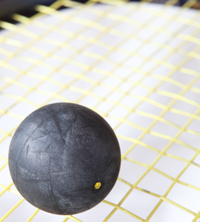|
|

The Trampoline Effect, Part II: When You Have Speed You Don't Need
By Steve Crandall
Vice President, Sales & Marketing
Ashaway Racket Strings

In our last column we talked about the trampoline effect and stringing low for power. But what about the opposite extreme? When, or why, or what kind of player might want to string at higher tension? What are the trade-offs involved? |
In our last column we talked about the trampoline effect - string low for power, high for control - and how Gregory Gaultier used lower tension in his racquet during the recent World's to increase the power and speed of his shots and beat the likes of Daryl Selby. But what about the opposite extreme? When, or why, or what kind of player might want to string at higher tension? What are the trade-offs involved?
Obviously, big strong players who have their own power might not need the additional power generated by lower string tension, and might opt for the improved control provided by high tension. But that's not the only case. Think about what power means in squash: it means ball speed. The faster the ball moves, the less time your opponent has to react to it.
Thus, you not only need to consider your own power, but the ability of the opponents you play as well. Gregory Gaultier certainly does not lack for power. But in playing against the likes of Daryl Selby and other world-class players, that extra speed proved definitive. So you have to ask, "In my game, against my range of competition, will I benefit from extra speed?"
You have to consider that the opposite end of the spectrum - stringing tight - means better control. This means a couple things. First, and again obviously, it means you can place your shots better. You can make your opponent travel farther to reach the ball, which can be the same or better than giving him less time to react to a faster moving ball.
Plus, a stiffer string bed means you can use more of the racquet effectively. This can enable you not only to pick off wall and drop shots, but be able to place them more accurately on the return. It broadens your sweet spot. Again, you have to ask, "How good am I? Can I handle off center shots, or in my game, will I benefit more from better control?"
So that's it in a nutshell. Unfortunately, squash racquets are not nutshells and the world is not that simple. The choice is not either/or. There are too many variables. For one thing, every player is different - which is to say unique - and not every player will get the same trampoline effect. For example, a number of players have told us that stringing at slightly lower tension - 26.5 lbs. compared to 28 or 29 - has given them a better sense of comfort and control. Are they the exceptions that prove the rule?
But then, strings are different as well. They are made of different materials, they are constructed in different ways, and they come in different gauges. Any or all of these variables can change how the trampoline effect works for you. Let's look at three quick examples:
1) A thinner string will tend to stretch more than a thicker string of the same material, at the same tension. Thus, according to the trampoline effect, you can expect to get more power using a 19 gauge string, than from an 18 gauge version of the same string. But what happens if you decrease the tension of the 19 gauge as well? Will you get even more power, or will reduced control negate the effect? What about reducing the tension of the 18 gauge string instead of going to the 19 gauge? Will that provide an equal increase in power, perhaps one with less decrease in control? These are nuances that only you can decide for yourself by experiment.
2) Different materials have different elastomeric properties. As we've said any number of times, Zyex® has greater dynamic stiffness than nylon. This means that at the same gauge and the same tension, a Zyex string will generate more power - it will stretch more and snap back faster - than nylon. But will the nylon give you better control? And what if you increased the tension of the nylon (or decreased the tension of the Zyex);would that help your game? Only you can say.
3) Finally, as we also said in our last column, the way strings are constructed is also a factor. For instance, a solid monofilament string will be stiffer when the ball hits the string bed than a string that has a smaller monofilament core with one, two or three wraps of smaller filaments around it. There will be more elasticity to the monofilament core type, since it is a thinner core. On the other hand, a multifilament string, which could have over a thousand separate filaments, will stretch more when the ball is hit. That means you'll get more power at the same tension.
Bottom line, whether or not you have 'speed you don't need' is a question only you can answer. As our old friend Natalie Grainger says, choosing a string and playing tension should be more of an intuitive choice than an academic exercise. "I don't think people are going to string and try to play like something: I think they should string to what feels good and how they play."
ZYEX® is a registered trademark of Victrex Ltd.
This article previously appeared in Squash Magazine.
|